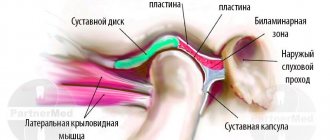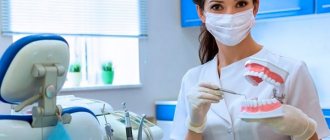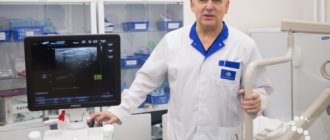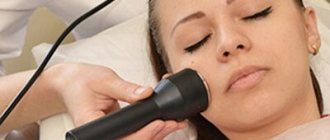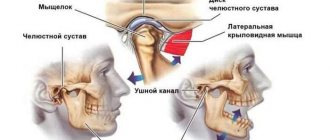2985
Splinting has always remained the main method of eliminating dysfunction of the TMJ (temporomandibular joint).
But, for some time now, most violations began to be corrected with specially designed joint splints.
The studies revealed that the defects respond well to treatment with the TMJ splint from MRC.
General information and purpose
The TMJ splint is a rigid, removable, thermo-modeling device that is worn like a mouthguard on one of the jaws.
The device is intended for intraoral use in adult patients. The design and construction were developed using a computer system. Supplied with preset parameters.
The splint is of great importance for doctors, as it allows them to begin correcting functional disorders already during the initial appointment.
System and oral care
Caring for the device and the oral cavity while wearing it is extremely simple and does not cause any difficulties. Necessary:
- After each use, rinse Myosa TMJ in warm running water, dry and place in its case.
- Clean it twice a week with a special cleaner, such as Myoclean TM from MRC.
Do not scratch, squeeze or chew the mouthguard. This can lead to delamination of its occlusal linings and impaired functionality in relation to the masticatory muscles and jaw position.
Design Features
Structurally, this device is a two-layer apparatus, the outer thermoplastic shell of which quickly softens when lowered into hot water.
Fitting onto the jaw arch, it sets it in the correct position due to the constant shape of its base.
The splint has a rigid wing-shaped base , the dimensions of which are considered ideal for decompression of the temporal joint. There are 2 models of the device available: with a base thickness of 4 mm or 2 mm.
Each wing of the device extends forward and backward beyond the molars by 2 mm and 2.5 mm, respectively, which provides effective support for the lateral dental units.
The stopper provided in the design restrains lateral movements, and a special tongue guard eliminates the possibility of the tongue sinking or swallowing.
Purpose of the T4k pre-orthodontic blue and pink trainer and its principle of operation.
Read here what problems can be solved with the help of orthodontic trainers for adults.
At this address https://www.vash-dentist.ru/ortodontiya/kapyi/ot-hrapa-alternativa-hirurgicheskomu-vmeshatelstvu.html we’ll talk about the effectiveness of an anti-snoring mouth guard and how it works.
Recommendations for use
- After placing the silicone element in the oral cavity, make sure that the tongue stabilizer is always in the upper part.
- Gradually closing your jaw, you should touch the surface of the splint with your teeth.
- Keep your mouth closed, trying to inhale only through your nose.
- Under no circumstances should you squeeze the device too tightly or try to chew it!
- If discomfort occurs due to the large size of the silicone element, you can cut off its ends.
- To prevent swelling, massage your gums with your finger 1-2 times a day.
Indications and restrictions
The role of the temporomandibular joint in performing articulatory and chewing functions is significant. Hundreds of thousands of movements are performed per day when a person eats, drinks, talks, facial movements, breathes and cleanses the oral cavity. Helps to fully carry out the closing and opening movements of the lower jaw, and its movement to the sides.
If there are disturbances in the dental system, the joint begins to function incorrectly, pain, dizziness, discomfort, swelling, and hearing loss appear.
The reasons leading to dysfunction are:
- malocclusion;
- an operation resulting in disruption of the TMJ function;
- any damage to the jaw;
- infection;
- stressful state;
- breathing through the mouth;
- congenital anatomical anomaly;
- pathological abrasion of teeth;
- excessive physical activity;
- abuse of solid foods.
Research shows that 35% of all patients are diagnosed with temporomandibular joint dysfunction. The first thing doctors prescribe is wearing a joint splint.
TMJ modification is recommended for patients suffering from joint dysfunction if they have:
- deviation from the normal position of the articular disc;
- clicking sound when moving the joint;
- difficulty opening the mouth.
Treatment of joint dysfunction using any modification of splints cannot be carried out if the patient’s medical history reveals:
- diseases of the central nervous system;
- neoplasms in the oral cavity;
- acute form of neurological condition.
Indications for use
TMJ is a multifunctional dental device that does not require special procedures before first use. The device can be prescribed to both adults and children over 7 years of age.
Orthodontists consider the following to be direct indications for wearing the device:
- Attacks of teeth grinding during sleep. The causes of the pathology are most often cited as uncontrolled use of psychotropic drugs, constant stress, malocclusion, and epilepsy.
- Overstrain of facial muscles. This leads to spasms of the chewing muscles.
- Rapid fatigue in the area of the masticatory muscle.
- Inability to swallow caused by foreign bodies, tumors, or scarring.
A reason to consult a doctor may also be one-sided pain of a throbbing nature, most often occurring in the temples or forehead. A displacement of the nasal septum is also fraught with serious consequences for the cartilage tissue connecting the skull and lower jaw.
Operating principle, wearing order
Thanks to the patented wing-shaped shape, the base of the splint creates the effects of gradual decompression and muscle relaxation.
Having the parameters of an ideal jaw arch, the device fixes the relative position of both jaws according to class I, while correcting the position of the mandibular arch and lateral parafunctionality.
The device does not cause any particular discomfort when worn and quickly adapts to the individual characteristics of the patient’s dental system. There is also no need to take an impression, and it must be further processed and adjusted before putting it on for the first time. Produced in universal sizes.
Placement (fitting) of the tire is quick (about 5 minutes) without any particular difficulties. At the end of the procedure, the person receives a comfortable individual splint that relieves joint problems.
In addition, the TMJ modification fits well even with partial edentia (the absence of a certain number of dental elements).
The entire fitting process takes place in the following sequence:
- Device for 2 min. placed in hot water.
- After this time, which is sufficient to soften the outer thermoplastic shell, it is removed and allowed to cool for about 10 seconds.
- Strengthens in physiological occlusion on the dentition. Due to the tight fit and low profile, ideal tire adhesion is ensured.
- The patient is offered for 20 seconds. Close your teeth tightly and breathe through your nose, creating a vacuum in your mouth.
- Afterwards, the device is removed and lowered into cold water to cool completely.
If necessary, the process of fitting the same device can be repeated several more times.
The device is designed for daytime wear : it should be worn while doing homework, reading, working at the computer, or watching TV. Does not interfere with a person’s ability to speak freely, does not distort speech, and does not cause discomfort or pain.
The patient will feel the first changes in the condition after the first couple of days of wearing it. Depending on the severity of TMJ dysfunction, the course of correction with a TMJ splint lasts from a month to six months.
Important! Ideally, a hard modification should be used in combination with a soft one (TMJ), designed for night wear.
In the first days of treatment, the sensitivity of the incisors may increase and mild pain may appear, which is considered a normal condition. In this case, doctors advise reducing the duration of wearing by 3-4 hours, and after normalization of the condition, bringing the prescribed treatment time to normal.
If, at the end of the course, the patient continues to complain of pain even in the absence of obvious symptoms of TMJ dysfunction (clicking joint, difficulty opening the mouth), the dentist decides to refer the patient to a neurologist to prescribe drug therapy.
What OrthoSnap aligners look like on teeth and when their use is justified.
In this publication you will find a detailed description of Star Smile aligners and the price of the product.
Here is all the most important information about T4A trainers.
About the manufacturer and its products
Australian orthodontist Chris Farrell is considered the founding father of myofunctional orthodontic appliances. After graduating from the University of Sydney with a degree in dentistry in 1971 and working for some time in Australia, Farrell went to England in 1977, where he continued his dental practice, while simultaneously mastering new methods of treating dental anomalies.
Having enriched himself with experience and new theoretical knowledge, the young researcher returned to his homeland and founded the Myofunctional Research (MRC) company in 1989. The main specialization of MRC was the development and production of myofunctional equipment for orthodontic treatment.
In the course of his professional and commercial activities, Dr. Farrell traveled to Russia several times, where he took part in exhibitions of orthodontic structures and conducted seminars for Russian orthodontists.
Chris Farrell currently lives and works in Australia, leading the company he created, which is now a recognized world leader in the development and manufacture of myofunctional orthodontic devices.
To date, MRC has developed three groups (families) of devices - MyOSA, Myobrace and Trainers. The last group includes devices of different functionality and design that cannot be classified as the first two.
Myofunctional Research myofunctional devices are known today all over the world and are used by practicing orthodontists in more than 100 countries. The number of types of MRCs, differing in design and functionality, is very large.
Any practicing orthodontist can easily select the optimal design for a specific clinical case. These may be the following options:
- Universal designs suitable for the treatment and/or prevention of a number of anomalies, and narrowly targeted devices that serve to relieve the patient primarily of one problem - night bruxism, snoring, apnea, malocclusion of a certain class.
- One or three sizes, which do not require adjustment to the jaw of a particular patient, and thermoplastic, molded using hot water to fit an individual jaw.
- Double-jaw mouthguards, which do not allow you to open your mouth while wearing the device, and single-jaw mouthguards, which allow you to talk while they are in your mouth.
- Used individually and in combination with other orthodontic structures, in particular braces.
- Intended for young children as pre-orthodontic devices, as well as for adolescents and adults.
- Made from soft and hard material, with or without a frame.
You should know that, despite the word “myo-” (“muscle-”) in the name of myofunctional devices, the vast majority of them also affect the condition of the TMJ, since the work of joints and muscles occurs simultaneously.
In addition, myofunctional mouthguards are also mechanical devices. Due to the elasticity of their walls, they exert pressure on individual, incorrectly positioned teeth and dental arches.
Thus, the action of myofunctional devices is complex , affecting all components of the dentofacial apparatus - occlusion, joints and muscles.
How in demand is the Johnson apparatus in orthodontics and its design features.
Come here to take a closer look at the Korkhaus apparatus.
At this address https://orto-info.ru/sistemyi-vyiravnivaniya-zubov/individualno-izgotovlennyie-apparatyi/begga.html we will consider the Begg apparatus in detail.
Expected effect
Important! Symptoms of TMJ dysfunction with timely treatment with the TMJ splint decrease or disappear completely without the use of additional procedures.
This device already helps in the first days of wearing:
- reduce acute pain and other symptoms;
- relieve the load from the joint;
- limit bruxism;
- eliminate parafunctional habits (for example, tongue swallowing);
- correct occlusion;
- eliminate reverse swallowing;
- cure mouth breathing;
- reduce the load on the dentition during athletic sports.
In addition to the therapeutic effect, the joint splint allows you to diagnose conditions that cause pain in the head and neck.
Joint splint
Joint splints are used for the prevention and treatment of diseases such as bruxism, malocclusion, and arthrosis. Therapy can be aimed at correcting the position of one or both jaws, reducing the load on joints and muscles, and eliminating injuries to the surface layer of enamel.
The peculiarity of using splints is that they can be worn at any age, especially for acute or chronic pain. Also, a similar treatment option is often prescribed for children, reducing discomfort.
Price
It is difficult to name the exact cost of the device. This figure, depending on the place of purchase, ranges from 3.5 thousand rubles. up to 4.5 thousand rubles
It is also important to take into account the fact that you will additionally have to pay for a consultation and x-ray, which is about another 1 thousand rubles.
Several other factors influence the cost of treatment:
- doctor's qualifications;
- status of the medical institution;
- the region of its location;
- pricing policy.
The exact cost of eliminating disorders in the TMJ should be found in the dental clinic where treatment is planned..
The video provides additional information on the topic of the article.
Reviews
Modification of the TMJ joint splint quickly corrects many temporal joint dysfunctions. The combination of unique design, treatment effectiveness, and affordable cost makes its use in demand.
You can talk about your experience in eliminating joint problems using this device or express your opinion regarding the effectiveness and rationality of using the splint by leaving a comment on this article.
If you find an error, please select a piece of text and press Ctrl+Enter.
Tags bite trainers
Did you like the article? stay tuned
Previous article
Restoration of pulpless teeth using Unimetric pins
Next article
Optragate in dentistry – easy for the specialist and comfortable for the patient
